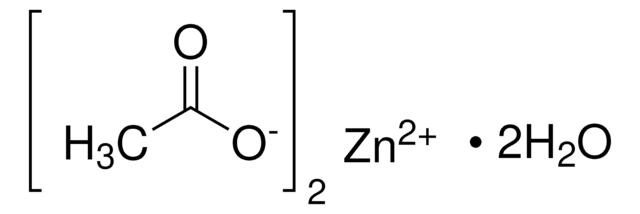793558
Sodium iodide
anhydrous, free-flowing, Redi-Dri™, ReagentPlus®, ≥99%
Sign Into View Organizational & Contract Pricing
All Photos(8)
About This Item
Linear Formula:
NaI
CAS Number:
Molecular Weight:
149.89
EC Number:
MDL number:
UNSPSC Code:
12352302
PubChem Substance ID:
NACRES:
NA.21
Recommended Products
grade
anhydrous
Quality Level
vapor density
>1 (vs air)
product line
ReagentPlus®
Redi-Dri™
Assay
≥99%
form
powder
quality
free-flowing
impurities
≤1.0% water
pH
6-9 (20 °C, 50 g/L)
mp
661 °C (lit.)
SMILES string
[Na+].[I-]
InChI
1S/HI.Na/h1H;/q;+1/p-1
InChI key
FVAUCKIRQBBSSJ-UHFFFAOYSA-M
Looking for similar products? Visit Product Comparison Guide
General description
Sodium iodide is an inorganic sodium salt. It is used as an iodinating agent in organic synthesis to prepare various iodine-containing compounds. It is used in the conversion of alkyl halides and sulfonates into alkyl iodides and aryl iodides via nucleophilic displacement reactions. Additionally, sodium iodide is also used in combination with oxidizing agents for the iodination of organoboranes, phenols, and aromatic compounds.
Application
Sodium iodide can be used as an iodine precursor salt to synthesize semi-organic nonlinear optical single crystal of bis thiourea sodium iodide (BTSI) via slow evaporation solvent technique.
Legal Information
ReagentPlus is a registered trademark of Merck KGaA, Darmstadt, Germany
Redi-Dri is a trademark of Sigma-Aldrich Co. LLC
Signal Word
Warning
Hazard Statements
Precautionary Statements
Hazard Classifications
Eye Irrit. 2
Storage Class Code
13 - Non Combustible Solids
WGK
WGK 3
Flash Point(F)
Not applicable
Flash Point(C)
Not applicable
Choose from one of the most recent versions:
Already Own This Product?
Find documentation for the products that you have recently purchased in the Document Library.
P E N Braad et al.
Physics in medicine and biology, 60(13), 5297-5312 (2015-06-26)
Peri-therapeutic (124)I-PET/CT is of interest as guidance for radioiodine therapy. Unfortunately, image quality is complicated by dead time effects and increased random coincidence rates from high (131)I-activities. A series of phantom experiments with clinically relevant (124)I/(131)I-activities were performed on a
Kohei Sano et al.
Biochemical and biophysical research communications, 464(3), 820-825 (2015-07-15)
Photoacoustic (PA) imaging is an attractive imaging modality for sensitive and depth imaging of biomolecules with high resolution in vivo. The aim of this study was to evaluate the effectiveness of an anti-epidermal growth factor receptor (EGFR) monoclonal antibody (panitumumab; Pan)
Mohamed Touati et al.
Leukemia & lymphoma, 56(2), 332-341 (2014-04-29)
Finding new prognostic factors to identify patients with Hodgkin lymphoma (HL) at risk of treatment resistance or relapse remains challenging in daily practice. We evaluated the relationship between CD68 expression, interim positron emission tomography (iPET) results and outcome in 158
Anke de Vries et al.
Investigative radiology, 50(4), 297-304 (2015-01-01)
The objective of this study was to investigate the feasibility and the accuracy of spectral computed tomography (spectral CT) to determine the tissue concentrations and localization of high-attenuation, iodine-based contrast agents in mice. Iodine tissue concentrations determined with spectral CT
Marlein Miranda Cona et al.
International journal of oncology, 44(3), 819-829 (2013-12-25)
Iodine-131‑labeled monoiodohypericin (131I‑Hyp) is a necrosis avid compound used as a complementary anticancer agent. Herein, the biodistribution in rats with re-perfused partial liver infarction (RPLI) was used to estimate its human internal radiation dosimetry. Iodine-123‑labeled monoiodohypericin (123I-Hyp) as a safer
Our team of scientists has experience in all areas of research including Life Science, Material Science, Chemical Synthesis, Chromatography, Analytical and many others.
Contact Technical Service








